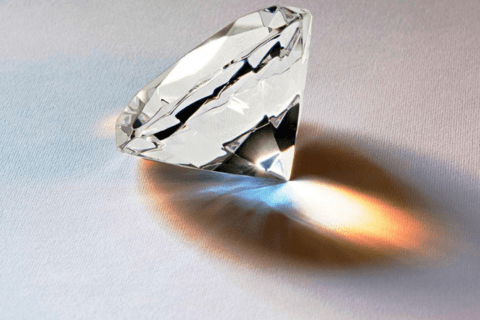In recent years, lab-grown diamonds have gained immense popularity due to their sustainability, affordability, and ethical sourcing. While these diamonds are chemically, physically, and optically identical to natural diamonds, understanding how to assess their quality is essential when buying them. This is where the 4Cs come into play. The 4Cs—Cut, Color, Clarity, and Carat weight—are the global standard for evaluating both natural and lab-grown diamonds. In this article, we will delve into the significance of each “C” and explain how they apply to lab diamonds.
Table of Contents
What Are Lab-Grown Diamonds?
Before diving into the 4Cs, let’s define what lab-grown diamonds are. Lab diamonds are diamonds that are created in a controlled laboratory environment using advanced technology that replicates the natural diamond formation process. There are two primary methods of creating lab-grown diamonds: High Pressure High Temperature (HPHT) and Chemical Vapor Deposition (CVD). Both methods result in diamonds with identical properties to those mined from the Earth. They are made from pure carbon and have the same hardness, brilliance, and physical properties.
The 4Cs of Lab Diamonds
1. Cut: The Key to Sparkle and Brilliance
The cut of a diamond significantly impacts its brilliance and sparkle. The cut refers to how well the diamond has been shaped and faceted. It’s one of the most important factors in determining the visual appeal of a diamond. While the cut is not a reflection of the diamond’s shape (which is a separate characteristic), it focuses on how effectively the diamond reflects light.
For lab-grown diamonds, just like natural diamonds, the cut is graded from Excellent to Poor based on the symmetry, proportions, and polish. A well-cut lab diamond will have maximum light reflection, making it sparkle and shine brilliantly.
Key factors that affect the cut include:
- Proportions: The angles and symmetry of the facets.
- Symmetry: The alignment of the facets and edges.
- Polish: The smoothness of the surface and the finish.
The better the cut, the higher the diamond’s value, as it enhances its brilliance and overall aesthetic.
2. Color: How Close to Colorless?
When it comes to lab-grown diamonds, color plays an essential role in grading. Lab grown diamonds come in various shades, but the most valuable diamonds are those that are closest to colorless. The Gemological Institute of America (GIA) uses a grading scale for diamond color that ranges from D (colorless) to Z (light yellow or brown).
- D-F: Colorless diamonds; the highest quality.
- G-J: Near-colorless diamonds; a slight hint of color can be detected.
- K-Z: Diamonds with noticeable color, typically yellow or brown.
Since lab diamonds are produced in a controlled environment, they often exhibit fewer color variations compared to natural diamonds, which can be subject to environmental factors. As a result, many lab diamonds are found to be near-colorless or even colorless.
3. Clarity: The Absence of Imperfections
Clarity refers to the presence of internal or external imperfections known as inclusions and blemishes. Since lab-grown diamonds are created under highly controlled conditions, they tend to have fewer inclusions compared to their natural counterparts. However, it’s still essential to assess clarity when purchasing a lab diamond.
The GIA uses a scale to grade diamond clarity:
- Flawless (FL): No inclusions or blemishes visible under 10x magnification.
- Internally Flawless (IF): No inclusions, but slight blemishes may be present.
- VVS1 and VVS2: Very, very slight inclusions that are difficult to detect.
- VS1 and VS2: Very slight inclusions that are somewhat easier to detect under magnification.
- SI1 and SI2: Inclusions that are noticeable to the trained eye.
- I1, I2, and I3: Inclusions visible to the naked eye.
Lab diamonds typically fall into the Flawless to VS2 categories, making them ideal for those looking for high clarity without the price tag of a flawless natural diamond.
4. Carat: Size Matters, but So Does the Weight
Carat weight refers to the size and weight of the lab diamonds 4Cs. While many buyers focus on carat weight, it’s important to note that carat does not indicate the quality of the diamond itself. A higher carat weight typically means a larger diamond, but two diamonds with the same carat weight may have different values depending on the cut, color, and clarity.
Lab-grown diamonds are often priced more affordably than natural diamonds of the same carat weight due to the difference in sourcing. As such, buyers can often afford a larger lab-grown diamond for the same budget as a smaller natural diamond.
Choosing the Right Lab Diamond for You
When shopping for a lab-grown diamond, it’s important to consider each of the 4Cs based on your personal preferences and budget. Here’s a quick guide to help you:
- If brilliance and sparkle are most important to you, prioritize the cut and choose an Excellent or Very Good grade.
- If you’re on a budget, a lab-grown diamond with a slightly lower color grade (like G or H) can still appear colorless to the naked eye, allowing you to get a larger diamond without compromising on its appearance.
- For high clarity, you can often afford a near-perfect clarity grade such as VS1 or VVS2, which ensures the diamond looks flawless at a much more affordable price than a natural diamond.
- For those seeking a larger diamond, carat weight becomes more affordable with lab-grown diamonds, allowing you to choose a bigger stone without overspending.
Conclusion: The Future of Diamond Shopping
Lab-grown diamonds are revolutionizing the diamond industry, offering a more affordable, sustainable, and ethical alternative to mined diamonds. Understanding the 4Cs when shopping for lab diamonds ensures that you’re making an informed decision about your purchase. Whether you prioritize cut, color, clarity, or carat, the world of lab diamonds offers you the ability to find the perfect stone tailored to your preferences.
With their growing popularity and advantages, lab diamonds are here to stay, and they are becoming the ideal choice for consumers looking for beauty, value, and responsibility in their diamond purchases.



